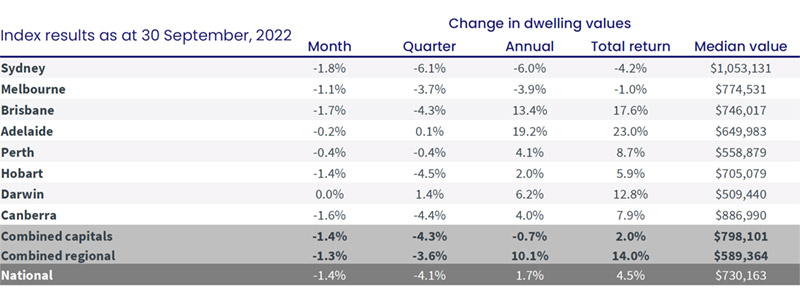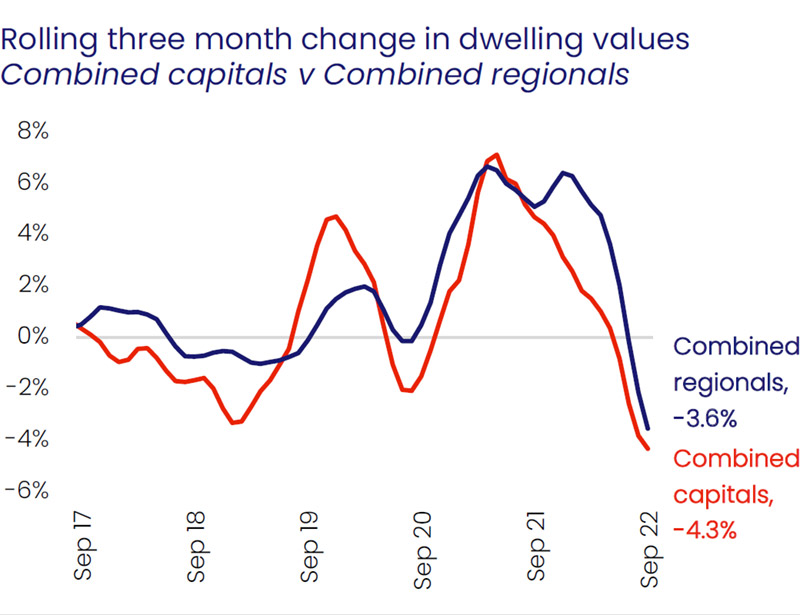No longer any state capitals with a growing property market
The pace of decline across the national property market has slowed but areas of growth are now limited to individual suburbs within the state capitals, all of which saw real estate prices fall overall in September.
The national hit to property prices across Australia’s state capitals is now complete, with Adelaide and Perth joining the ranks of those in decline.
The previous outliers have slipped into negative territory, with Adelaide housing values easing back by 0.2 per cent and Perth by 0.4 per cent in September.
Nationally, after rising 25.5 per cent over the recent growth cycle, housing values across the combined capitals index are now 5.5 per cent below the recent peak, or in dollar terms, down approximately $46,100.
At the combined capital city level, housing values would need to fall a further 13.5 per cent before wiping out the gains of the recent growth cycle, while Melbourne, which saw a softer upswing than other regions (17.3 per cent from trough to peak), would only need to see a 4.3 per cent fall in values before returning to pre-COVID levels.
Sydney’s monthly rate of decline eased from minus 2.3 per cent in August to minus 1.8 per cent in September, Melbourne tapered from -1.2 per cent to -1.1 per cent and Brisbane falls went from -1.8 per cent to -1.7 per cent. Darwin housing values have not started to trend lower, although dwelling values remain 10.1 per cent below their 2014 peak.
According to CoreLogic’s research director, Tim Lawless, it is probably too early to suggest the housing market has moved through the worst of the downturn.
“It’s possible we have seen the initial shock of a rapid rise in interest rates pass through the market and most borrowers and prospective home buyers have now ‘priced in’ further rate hikes, however, if interest rates continue to rise as rapidly as they have since May, we could see the rate of decline in housing values accelerate once again.”
“We are still seeing some resilience to value falls around the more affordable areas of Adelaide and Perth, as well as some regional markets associated with agriculture, mining and tourism,” Mr Lawless said.

Source: CoreLogic Home Value Index October 2022
REIWA President Damian Collins said that while Perth prices had slipped into negative territory, there were still areas of strong growth.
“WA is still in an excellent position for price growth with our strong economy, growing population and limited stock levels.”
The five suburbs to record the biggest increase in price during September were Singleton (3.9 per cent to $535,000), Ocean Reef (2.8 per cent to $915,000), Beckenham (2.7 per cent to $467,500), Bibra Lake (2.7 per cent to $610,000) and South Perth (2.5 per cent to $1.55 million). Other suburbs to perform well were Falcon, Safety Bay, Dawesville, Bullsbrook and Melville.
The largest cumulative falls around the country have been concentrated in areas of Sydney’s Northern Beaches, including Warringah, Pittwater and Manly, where housing values are down at least 14.5 per cent since moving through a peak in early 2022, as well as flood affected areas across Richmond-Tweed.
“These areas saw housing values rise between 38 per cent and 62 per cent through the growth cycle, so most homeowners are still well ahead in terms of equity in their home,” Mr Lawless said.
Regionals reeling
Regional prices are falling even more sharply than the worst of the capitals.
The combined regionals index, which recorded stronger growth conditions through the upswing (41.6 per cent), peaked two months later than the capital cities (June 2022), with values down 3.6 per cent through to the end of September (approximately -$21,700).
The only states to record regional growth over the past month were Western Australia (0.3 per cent) and South Australia (0.5 per cent). Regional Tasmania and New South Wales led the falls, both slipping 1.7 per cent.

Source: CoreLogic Home Value Index October 2022
Regional rents are still attracting higher yields than their city counterparts.
Capital city gross yields (3.36 per cent) are now at the highest level since January 2021 after rising 40 basis points from the February 2022 record low. This was largely led by a 55 basis point rise in unit yields, while house yields rose by 23 basis points.
Despite rising by a smaller 24 basis points, regional yields are substantially higher than gross yields across the combined capitals at 4.3 per cent and 3.4 per cent respectively.
Unit markets around the country are now outpacing houses in the rate of price decline, with the east coast state capitals leading the downhill charge.
Rents still rising
Rents around the country continue to rise but not at the rate that might be expected given the lack of supply of rental properties and record low vacancy rates around the country.
The national rental index increased by 0.6 per cent in September, the lowest monthly rise in rents since December 2021.
At the national level, rental growth moved through a peak in May 2022 with a 1.0 per cent rise; since that time, the monthly pace of rental growth has been easing.
This trend in rents is evident across most regions, but has been clearest across regional Australia where monthly rental increases have reduced from a peak of 1.4 per cent in January 2021 to just 0.3 per cent in September 2022.
“A gradual slowdown in rental growth in the face of such low vacancy rates could be an early sign that renters are reaching an affordability ceiling,” Mr Lawless said.
Since the onset of COVID, capital city rents have risen 16.5 per cent and regional rents are up 25.1 per cent.
“It’s likely renters will be progressively seeking rental options across the medium to high density sector, where renting is cheaper, or maximising the number of people in the tenancy in an effort to spread higher rental costs across a larger household,” Mr Lawless said.
Further evidence of a shift of rental demand towards higher density options can be seen in the higher growth rate of unit rents over house rents.
Capital city unit rents increased by 3.8 per cent over the September quarter compared with a 2.3 per cent rise in house rents.
This trend is broad-based, with every capital city apart from Perth recording a faster rise in unit rents than house rents.
Perth’s rental stock levels are at their lowest in 12 years, despite a 20 per cent higher population competing for that pool of rentals.
Most hoping prices fall further
Australians remain divided on their outlook for the property market over the next 12 months but the balance leans towards an expectation prices will continue to fall.
More than half (55 per cent) expect prices to remain the same or only shift slightly up or down. When it comes to those expecting a significant change, 16 per cent expect a large drop but only 6 per cent predict a large price increase.
The study by Budget Direct also found that respondents over 55 years of age suggested their financial situation had improved in the past 12 months but every other age bracket noted averaged decreases to their financial situations.
But headlines portraying property price falls as bad news are off the mark.
As many struggle to get a foot on the property ladder and rent hikes make life harder for non-owners, the study found that overall, the Australian population would prefer to have property prices decrease in the next 12 months.
A significant portion of Australians remain active in the property market.
More than half of respondents (52.2 per cent) said they either bought a property in the last two years, or they are looking to buy in the next two.



















